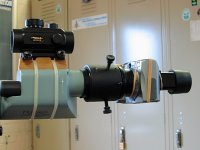stanfairgrieve
Active member
Does anyone have any experience in fitting a Tele Vue Qwix Point to a Leica APO-Telvid 77. Are they any good, where I can buy one and how much do they cost ?
Or maybe someone has ideas for making it easier to find the subject/bird with the scope prior to taking the shot.
Maybe a DIY finder scope.
It would need to fit an angled eyepiece scope
Stan
Or maybe someone has ideas for making it easier to find the subject/bird with the scope prior to taking the shot.
Maybe a DIY finder scope.
It would need to fit an angled eyepiece scope
Stan





